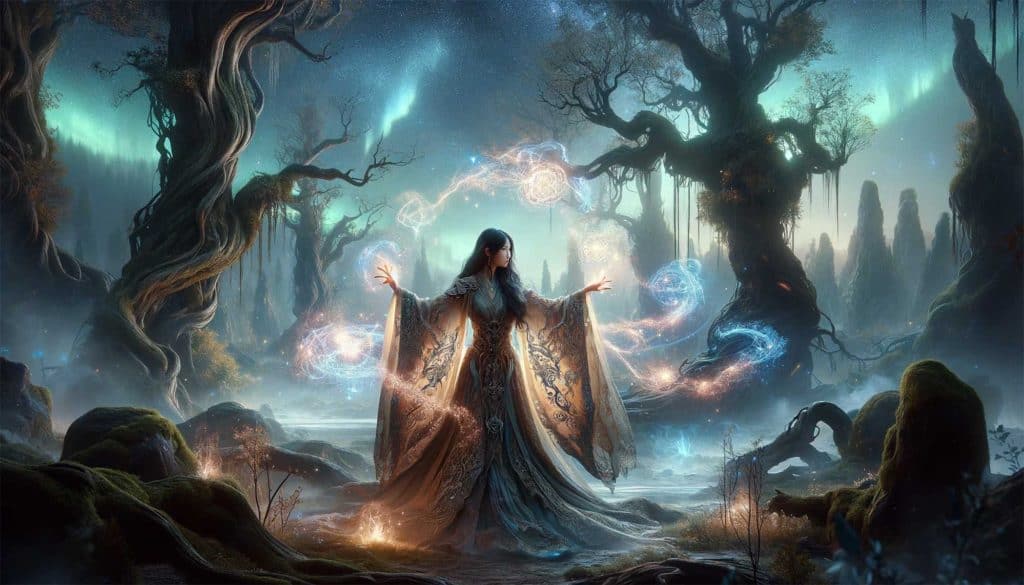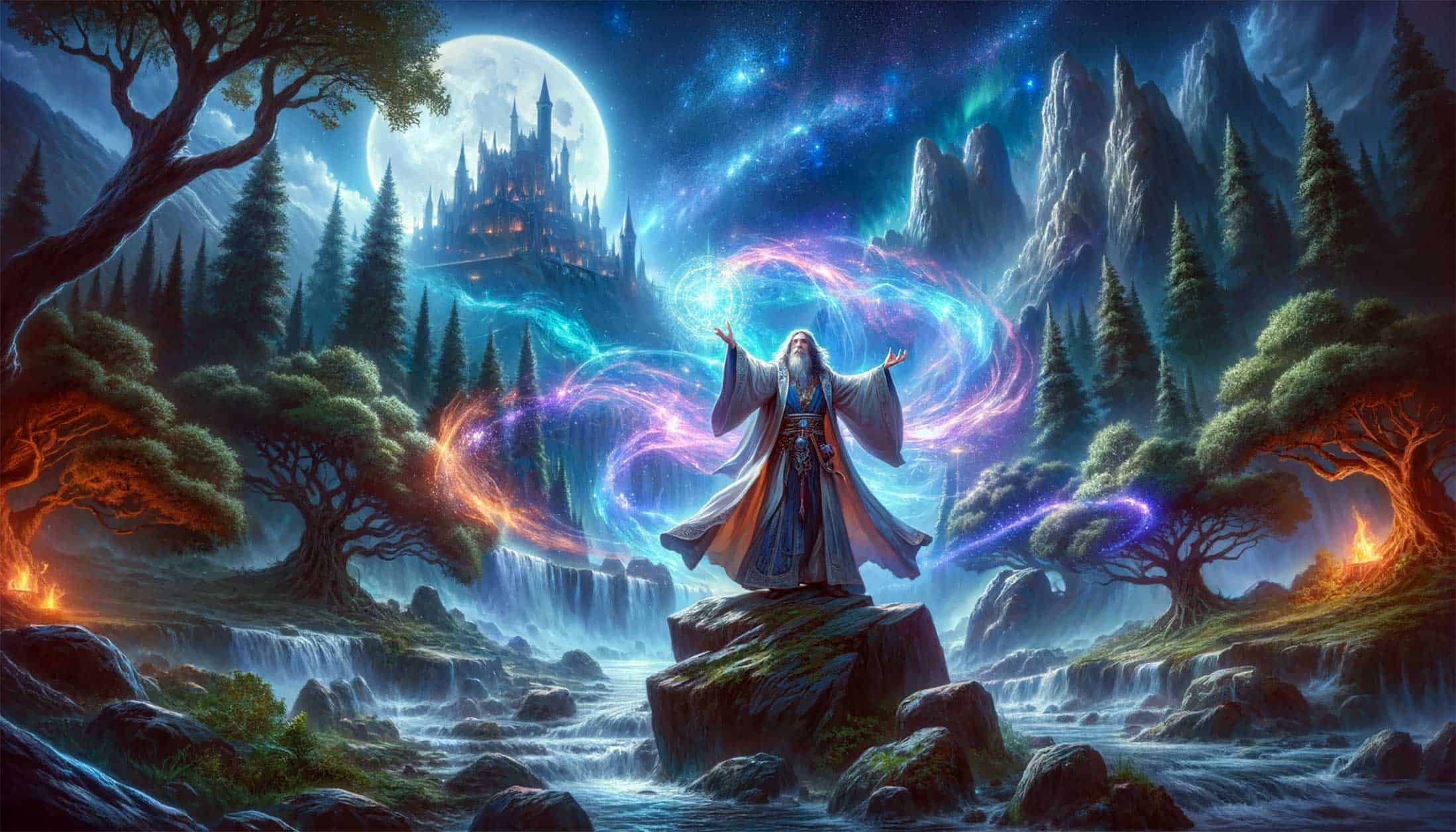Dungeons & Dragons (D&D), a name that resonates with echoes of clashing swords, mystical spells, and epic adventures, has been a cornerstone of tabletop role-playing games since its inception in the early 1970s. Created by Gary Gygax and Dave Arneson, it has evolved from a simple war game into a complex and richly detailed fantasy world, captivating the imaginations of millions. At the heart of this transformation and the very essence of D&D’s allure lies its magic system, a fundamental aspect that has undergone significant evolution over the years.
Magic in D&D is not just a set of rules or a list of spells. It’s a narrative tool, a source of limitless creativity, and a way for players to interact with the game’s world in a profoundly personal manner. From wizards weaving spells from ancient tomes to clerics channeling the divine power of their deities, magic infuses every corner of D&D’s multiverse with wonder and mystery. It’s a testament to the game’s depth and its designers’ ingenuity that the magic system has continually adapted, reflecting both the changing tastes of its players and the advancements in role-playing game mechanics.
As we embark on this exploration of D&D’s magical evolution, we’ll uncover how each edition of the game has shaped and been shaped by its approach to the arcane arts. From the rigid structures of its early days to the more flexible and narrative-driven systems of modern editions, the journey of magic in D&D is as enchanting as it is enlightening. Let’s turn the pages of this grand tome and begin our deep dive into the mystical lore that has powered one of the greatest role-playing games of all time.
The Early Years: Origins and Basic Mechanics
In the realm of Dungeons & Dragons, the initial foray into magic was as groundbreaking as it was rudimentary. The original D&D, released in 1974, introduced players to a fantasy world where magic was both a powerful tool and a mysterious art to be mastered. The game’s magic system was heavily inspired by the works of Jack Vance, particularly his “Dying Earth” series. This influence led to the adoption of what is now known as the Vancian magic system, named after the author.
The Vancian system was characterized by its “spell preparation” mechanic. Wizards, or magic-users as they were then known, had to prepare spells in advance and could only use them a limited number of times before needing to rest and re-memorize them. This approach to magic was both a strategic element and a limitation, forcing players to think carefully about their spell choices and usage. It was a system that mirrored the resource management aspects of the game, adding a layer of depth and strategy to spellcasting.
Moreover, the original magic system was relatively simple, with a limited spell list and straightforward mechanics. This simplicity was partly due to the technological and conceptual limitations of the time. However, it laid the foundation for the complex and richly detailed magic systems that would come in later editions. The early years of D&D’s magic were about planting the seeds of imagination in the minds of players, setting the stage for the incredible growth and evolution that was yet to come.
Try my AI Tabletop RPG generators...and an extensive library of content!
Advancements and Expansions: AD&D and Beyond
The advent of Advanced Dungeons & Dragons (AD&D) in the late 1970s and early 1980s marked a significant evolution in the game’s magic system. With the release of AD&D 1st Edition, the world of D&D saw an expansion in the depth and complexity of its magical lore. The spell list was greatly expanded, introducing a plethora of new spells that offered a wider range of magical effects and strategic possibilities. This expansion allowed for a richer and more varied spellcasting experience, as players now had a more extensive arsenal of magical abilities at their disposal.
Furthermore, AD&D introduced new magical classes and subclasses, each with its unique approach to the arcane. This diversification of magical practitioners brought new dimensions to gameplay and storytelling. For instance, the introduction of the sorcerer and warlock classes in later editions offered alternative ways of spellcasting that differed from the traditional Vancian system. These classes were not bound by the same spell preparation mechanics, instead using a points-based system or other mechanics to represent their innate magical abilities.
The magic system in AD&D also began to integrate more heavily with the game’s narrative and world-building aspects. Spells and magical items were often tied to the lore of the game’s world, imbuing them with a sense of history and significance. This integration made magic feel more organic and a more integral part of the game’s universe. The changes brought by AD&D and its subsequent versions represented a shift towards a more nuanced and story-driven approach to magic, setting the stage for further innovations in the editions to come.
The D20 Revolution: D&D 3rd Edition
The launch of Dungeons & Dragons 3rd Edition heralded a pivotal moment in the evolution of the game’s magic system. This edition, embracing the innovative D20 System, fundamentally altered how magic was used and perceived in the game. The D20 System streamlined many of the game’s mechanics, including spellcasting, using a twenty-sided die for most in-game actions. This shift not only simplified the gameplay but also made it more uniform and intuitive, especially for newcomers.
⚔️ Fantasy RPG Random Tables Books
Make life as a Gamemaster easier…
If you play Dungeons & Dragons, Pathfinder, or other fantasy RPGs, this
RPG random tables series
is packed with encounters, NPCs, treasure, and more. Available in eBook or print—either way, you’ll have a wealth of adventure ideas at your fingertips.
Major Overhaul and Systematic Changes
The introduction of the D20 System in the 3rd Edition was more than just a change in mechanics; it was a reimagining of how magic interacted with the game’s world. The system brought a sense of consistency to spellcasting, making it easier to understand and more integrated with other aspects of gameplay. Spellcasters now had a more consistent framework for how their spells worked and interacted with the game’s environment and other characters. This change represented a significant departure from the more segmented and varied rules of previous editions, paving the way for a more unified and streamlined approach to the game’s magic system.
Refinement and Expansion of Magic
Beyond systematization, the 3rd Edition also focused on refining and expanding the magical aspects of D&D. The spell list was further enriched, offering a greater variety of spells that catered to different playstyles and narrative themes. This expansion not only added depth to the gameplay but also provided players and Dungeon Masters with more tools to craft their stories and adventures. The 3rd Edition’s approach to magic emphasized flexibility and creativity, allowing for a more personalized and varied magical experience.
Modern Magic: 4th and 5th Editions
The evolution of Dungeons & Dragons reached new heights with its 4th and 5th editions, each bringing its unique flavor and innovations to the magic system.
Streamlining and Changes in the 4th Edition
The 4th Edition of D&D, introduced in 2008, marked a significant departure from previous editions in terms of both overall gameplay and the magic system. This edition was characterized by a streamlined approach, aiming to balance different classes and simplify mechanics. The magic system was overhauled to fit this new paradigm. Spells were categorized into “at-will,” “encounter,” and “daily” powers, each with distinct usage frequencies, adding a strategic layer to spellcasting. This structure made magical combat more accessible and easier to manage, particularly for new players. However, it also represented a shift towards a more game-centric, less narrative-driven approach, which was met with mixed reactions from the D&D community.
The Blend of Old and New in the 5th Edition
In response to feedback and the evolving landscape of tabletop RPGs, the 5th Edition, released in 2014, sought to harmonize the innovations of its predecessors with the traditional elements that long-time fans cherished. This edition is lauded for its flexibility, accessibility, and its return to a more narrative-driven approach. The magic system in the 5th Edition is a testament to this blend, merging the streamlined mechanics of the 4th Edition with the depth and complexity of earlier editions. Spellcasting in the 5th Edition is intuitive yet rich, offering a wide array of choices and creative freedom to players. This edition’s magic system strikes a balance, catering to both veterans and newcomers, and firmly establishes itself as a pivotal point in the ongoing evolution of D&D’s magical lore.

Player Impact and Creative Freedom
The evolving nature of the magic system in Dungeons & Dragons has significantly influenced player creativity and game dynamics over the decades. Each edition’s approach to magic has opened new avenues for storytelling, character development, and strategic gameplay.
Encouraging Creativity and Flexibility
The advancements in the game’s magic system, especially in the latest editions, have empowered players to be more creative and flexible in their approach to spellcasting. The expanded spell lists, along with the introduction of new classes and magical mechanics, have given players a vast sandbox to experiment with. This level of variety allows players to craft unique spellcasters, each with their own distinct magical style and narrative. The system encourages players to think beyond the mechanics, integrating their spells and magical abilities into their character’s backstory and the larger story being told at the table.
Influencing Game Dynamics and Storytelling
The changes in D&D’s magic system have also had a profound impact on game dynamics and storytelling. In early editions, the limitations of the Vancian system added a strategic layer to the game, as players had to carefully plan their spell use. In contrast, later editions, with their more flexible and accessible magic systems, have allowed for a more spontaneous and dynamic form of play. This shift has not only affected how battles are fought but also how stories unfold. Magic has become a more integrated part of the narrative, often serving as a key element in the plot or character development.
The evolution of the magic system in D&D reflects a broader trend in tabletop RPGs towards more player-driven, narrative-rich experiences. As the game continues to evolve, its magic system remains a vital and ever-changing aspect, continually offering new possibilities for creativity, storytelling, and adventure.
Conclusion: Magic in DND
The journey through the evolution of the magic system in Dungeons & Dragons is a tale as enchanting as the spells woven within the game itself. From the early days of the original D&D to the refined and expansive world of the 5th Edition, magic has been a central, evolving force, shaping the way players engage with this legendary game.
Reflecting on this journey, we see a narrative of continuous innovation and adaptation. Each edition of D&D has contributed something unique to the magic system, from the strategic complexities of the Vancian system to the streamlined and flexible mechanics of the latest editions. These changes have not only mirrored the evolving tastes and preferences of the gaming community but have also pushed the boundaries of what is possible in a tabletop RPG.
⚔️ Fantasy RPG Random Tables Books
Make life as a Gamemaster easier…
If you play Dungeons & Dragons, Pathfinder, or other fantasy RPGs, this
RPG random tables series
is packed with encounters, NPCs, treasure, and more. Available in eBook or print—either way, you’ll have a wealth of adventure ideas at your fingertips.
Looking to the future, the role of magic in Dungeons & Dragons promises to remain a vital and dynamic aspect of the game. As new editions and expansions are developed, we can anticipate further innovations that will continue to challenge and delight players. The magic system, in all its forms, will undoubtedly continue to be a source of endless creativity, storytelling depth, and immersive gameplay for old and new players alike.
In the end, the evolution of D&D’s magic system is a testament to the game’s enduring appeal and its ability to adapt and grow. It’s a magical journey that invites each player to be a part of its ongoing story, creating their own legends and adventures in the vast, mystical realms of Dungeons & Dragons.










